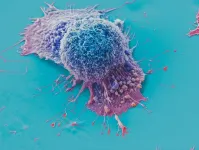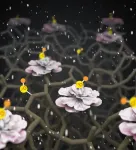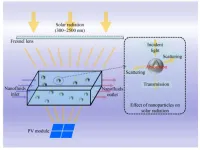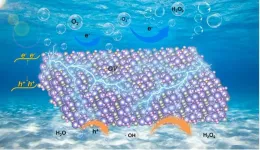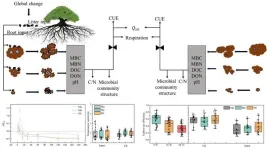(Press-News.org) In posttraumatic stress disorder (PTSD), intrusive thoughts, changes in mood, and other symptoms after exposure to trauma can greatly impact a person’s quality of life. About 6 percent of people who experience trauma develop the disorder, but scientists don’t yet understand the neurobiology underlying PTSD.
Now, a new genetic study of more than 1.2 million people has pinpointed 95 loci, or locations in the genome, that are associated with risk of developing PTSD, including 80 that had not been previously identified. The study, from the PTSD working group within the Psychiatric Genomics Consortium (PGC - PTSD) together with Cohen Veterans Bioscience, is the largest and most diverse of its kind, and also identified 43 genes that appear to have a role in causing PTSD. The work appears in Nature Genetics.
“This discovery firmly validates that heritability is a central feature of PTSD based on the largest PTSD genetics study conducted to date and reinforces there is a genetic component that contributes to the complexity of PTSD,” said Caroline Nievergelt, co-first and corresponding author on the study and a professor in the Department of Psychiatry at the University of California, San Diego. Adam Maihofer, a genetic epidemiologist in Nievergelt’s lab, was a co-first author as well.
The findings both confirm previously discovered genetic underpinnings of PTSD and provide many novel targets for future investigation that could lead to new prevention and treatment strategies.
“It's exciting that we see the exponential increase in loci with increases in sample size we see for other disorders,” said Karestan Koenen, senior author on the study, an institute member of the Broad Institute of MIT and Harvard, and an investigator with the Stanley Center for Psychiatric Research at Broad. Koenen leads the Stanley Center’s Biology of Trauma Initiative and the Global Neuropsychiatric Genomics Initiative, and is a professor of psychiatric epidemiology at the Harvard T. H. Chan School of Public Health. “This is a milestone for PTSD genetics.”
Genetic roots
Previous twin and genetic studies, including an investigation by the same team in 2017 and an expanded study in 2019, showed that PTSD has a genetic component, and that many genes contribute to the condition.
But these analyses pointed to different genetic loci across datasets, and many studies struggled to distinguish loci that were specific to PTSD risk from those that were also linked to conditions such as depression and cardiovascular disease. Genetic datasets have also historically focused on people of European ancestry, even though there is a disproportionately high burden of trauma and PTSD among people of African, Native American, and Latin American ancestry in the United States and globally.
In the new study, Nievergelt, Koenen, and other researchers from the PGC compiled data from 88 different genome-wide association studies, which use genetic data from large groups of people to look for associations between regions of the genome and the chance of developing a condition or trait. In all, the dataset contained information about the risk of developing PTSD from more than 1.2 million individuals of European ancestry (including about 140,000 with PTSD), about 50,000 with African ancestry (including about 12,000 with PTSD), and about 7,000 with Native American ancestry (about 2,000 with PTSD).
Meta-analysis of the data revealed 95 loci strongly associated with PTSD, including 80 that had not been identified previously. Forty three genes appeared to play a role in causing PTSD, including some that affect brain cells called neurons, brain chemicals called neurotransmitters, ion channels (which allow ions to pass in and out of cells), connections between neurons called synapses, and the endocrine and immune systems. The researchers found that PTSD shared many genetic features with depression, as well as several PTSD-specific loci.
Although previous studies found a higher prevalence of PTSD in females than males, the researchers did not find evidence for this in their data. They examined the X chromosome, which earlier studies did not do, and found five loci linked with PTSD. But they add that these changes on the X chromosome would have similar effects in males and females.
To more deeply probe how PTSD genetics affect the brain, the team studied gene expression data and found that the cerebellum, the brain region that controls movement and balance, may be involved in the disorder in addition to regions scientists have previously connected with PTSD, such as the cortex and amygdala. In particular, the research team found that interneurons, which connect motor and sensory neurons, were involved in PTSD risk. Future studies could help determine how key genes in these tissues and cells affect PTSD symptoms and behaviors.
“For the first time, we are approaching a genetic architecture for PTSD, which both validates prior understanding of some of the critical biology underlying trauma-related disorders, while also pointing towards exciting and novel new targets and mechanisms,” said Kerry Ressler, a co-leader of the PGC - PTSD working group, chief scientific officer at McLean Hospital, and Professor of Psychiatry at Harvard Medical School. “These data are an important first step in next generation approaches to novel interventions for PTSD.”
In line with previous findings, Nievergelt, Koenen, and their colleagues also found that polygenic scores — a calculation of a person’s genetic chance of developing a certain condition based on millions of single-letter changes in their DNA — for PTSD risk are not readily translatable across populations. The researchers say this disparity highlights the importance of continuing to expand the depth and diversity of populations included in future studies of PTSD.
“We know that trauma and PTSD disproportionately affects under-resourced populations globally, particularly African ancestry populations,” said Koenen. “Our next steps will focus on addressing that inequity through partnerships with African scientists to make sure research in PTSD genetics benefits everyone equally.”
Funding:
This work was supported by the National Institute of Mental Health, Cohen Veterans Bioscience, and the Stanley Center for Psychiatric Research at the Broad Institute.
Paper cited:
Nievergelt CM, Maihofer AX et al. Genome-wide association analyses identify 95 risk loci and provide insights into the neurobiology of post-traumatic stress disorder. Nature Genetics. Online April 18, 2024. DOI: 10.1038/s41588-024-01707-9.
About Broad Institute of MIT and Harvard
Broad Institute of MIT and Harvard was launched in 2004 to empower this generation of creative scientists to transform medicine. The Broad Institute seeks to describe the molecular components of life and their connections; discover the molecular basis of major human diseases; develop effective new approaches to diagnostics and therapeutics; and disseminate discoveries, tools, methods and data openly to the entire scientific community.
Founded by MIT, Harvard, Harvard-affiliated hospitals, and the visionary Los Angeles philanthropists Eli and Edythe L. Broad, the Broad Institute includes faculty, professional staff and students from throughout the MIT and Harvard biomedical research communities and beyond, with collaborations spanning over a hundred private and public institutions in more than 40 countries worldwide.
END
Scientists uncover 95 regions of the genome linked to PTSD
Findings from the largest genetic study of PTSD to date could help explain why only some people develop the condition after experiencing trauma.
2024-04-18
ELSE PRESS RELEASES FROM THIS DATE:
AI tool predicts responses to cancer therapy using information from each cell of the tumor
2024-04-18
With more than 200 types of cancer and every cancer individually unique, ongoing efforts to develop precision oncology treatments remain daunting. Most of the focus has been on developing genetic sequencing assays or analyses to identify mutations in cancer driver genes, then trying to match treatments that may work against those mutations.
But many, if not most, cancer patients do not benefit from these early targeted therapies. In a new study published on April 18, 2024, in the journal Nature Cancer, first author Sanju Sinha, Ph.D., assistant professor in the Cancer Molecular Therapeutics ...
CEOs’ human concern translates into higher stock price
2024-04-18
Compassionate leadership has tangible benefits: CEOs’ expressions of empathy correlate with positive stock performance, a study led by the University of Zurich shows. The researchers analyzed data from conference calls between CEOs and financial analysts during the COVID-19 pandemic.
The COVID-19 pandemic prompted an unprecedented financial crisis. Between 24 February 2020, and 20 March 2020, the value of U.S. companies on the stock market decreased significantly, surpassing the decline during the 2008-2009 financial crisis.
At the onset of the pandemic, several CEOs made statements ...
Smoking-related deaths could be reduced if people attending lung cancer screening are offered stop-smoking support
2024-04-18
A new study has found that by offering stop smoking support as part of the national lung cancer screening programme, there is potential to save lives, and dedicated funding must be considered by policy makers.
The results of the study, published in the European Respiratory Journal, showed that offering stop smoking support at the same time and in the same place as lung screening, resulted in a high uptake of support across a range of demographic characteristics.
This has the potential to reduce smoking-related illness and death in a high-risk ...
Quick decisions in soccer enhanced by brain’s ability to suppress actions
2024-04-18
To pass or not to pass, that is the question faced by soccer players the world over in every match. It might be unsurprising that higher skilled players exhibit better execution of actions than lower skilled ones, but now an Osaka Metropolitan University-led research team has evidence that the neural process to suppress actions also plays an important role.
Research Center for Urban Health and Sports Assistant Professor Takahiro Matsutake and colleagues conducted an experiment to see how three levels of soccer players perform when faced with the same tasks.
The ...
Recycling CFRP waste is a challenge, but we've found a way to make it work
2024-04-18
Carbon fiber reinforced plastics (CFRP) are lighter and stronger than metal and are used in a variety of industries, including aviation, aerospace, automotive, marine, and sporting goods. In recent years, it has also been applied to new industries such as air mobility, which has led to an increase in its use and a waste disposal problem. However, CFRP is not naturally degradable, and high-temperature incineration methods emit toxic substances and cause environmental pollution, so it is urgent to develop ...
Advanced nuclear magnetic resonance technique developed to reveal precise structural and dynamical details in zeolites
2024-04-18
Zeolites are widely used in many industries. There is still a need to fully understand their intrinsic catalytic nature due to the complexity of the hydroxyl-aluminum moieties.
Atomic-scale analysis of local environments for the hydroxyl species is essential for revealing the intrinsic catalytic activity of zeolites and guiding the design of high-performance catalysts. However, many unfavorable factors prohibit the elucidation of their fine structures such as low quantity, meta-stable property, structural similarity, ...
Advancing performance assessment of a spectral beam splitting hybrid PV/T system with water-based SiO2 nanofluid
2024-04-18
As the globe grapples with the urgent need to shift from fossil fuels to sustainable energy sources, solar power stands as a beacon of hope. However, a significant challenge has been to efficiently capture and utilize the full spectrum of sunlight. Traditional photovoltaic (PV) panels convert sunlight into electricity but can't use the entire solar spectrum, especially the infrared part which is often wasted as heat. To address this, photovoltaic/thermal (PV/T) systems have been developed. These hybrid systems ...
Researchers realize target protein stability analysis by time-resolved ultraviolet photodissociation mass spectrometry
2024-04-18
How mutations impact protein stability and structure dynamics is crucial for understanding the molecular mechanism of the disease and the targeted drug design. However, probing the molecular details of mutation-induced subtle structure dynamics is still challenging.
Recently, a research group led by Prof. WANG Fangjun from the Dalian Institute of Chemical Physics (DICP) of the Chinese Academy of Sciences developed a time-resolved native mass spectrometry (TR-nMS) strategy coupled with ultraviolet photodissociation (UVPD) analysis. This ...
Oxygen vacancies mediated ultrathin Bi4O5Br2 nanosheets as efficient piezocatalyst for synthesis of H2O2 from pure water
2024-04-18
As an important chemical raw material, hydrogen peroxide (H2O2) is widely applied in various aspects of industry and life. The industrial anthraquinone method for H2O2 production has the serious flaws, such as high pollution and energy consumption. By using ubiquitous mechanical energy, piezocatalytic H2O2 evolution has been proven as a promising strategy, but its progress is hindered by unsatisfied energy conversion efficiency.
Bi4O5Br2 is regarded as a highly attractive photocatalytic material due to its unique sandwich ...
Warming and exogenous organic matter input affected temperature sensitivity and microbial carbon use efficiency of agricultural soil respiration on the Qinghai-Tibet Plateau
2024-04-18
The Qinghai-Tibet Plateau is one of the most dramatically affected regions by global warming. For a long time, the region has been exposed by low temperature and soil moisture, which led to the severe inhibition of the soil biological activities and decomposition enzyme systems. As a result, the soil organic matter in this region decomposes slowly and accumulates in large quantities, underscoring its substantial potential for carbon release. In the face of climate warming, the low-temperature limiting ...
LAST 30 PRESS RELEASES:
Making lighter work of calculating fluid and heat flow
Normalizing blood sugar can halve heart attack risk
Lowering blood sugar cuts heart attack risk in people with prediabetes
Study links genetic variants to risk of blinding eye disease in premature infants
Non-opioid ‘pain sponge’ therapy halts cartilage degeneration and relieves chronic pain
AI can pick up cultural values by mimicking how kids learn
China’s ecological redlines offer fast track to 30 x 30 global conservation goal
Invisible indoor threats: emerging household contaminants and their growing risks to human health
Adding antibody treatment to chemo boosts outcomes for children with rare cancer
Germline pathogenic variants among women without a history of breast cancer
Tanning beds triple melanoma risk, potentially causing broad DNA damage
Unique bond identified as key to viral infection speed
Indoor tanning makes youthful skin much older on a genetic level
Mouse model sheds new light on the causes and potential solutions to human GI problems linked to muscular dystrophy
The Journal of Nuclear Medicine ahead-of-print tip sheet: December 12, 2025
Smarter tools for peering into the microscopic world
Applications open for funding to conduct research in the Kinsey Institute archives
Global measure underestimates the severity of food insecurity
Child survivors of critical illness are missing out on timely follow up care
Risk-based vs annual breast cancer screening / the WISDOM randomized clinical trial
University of Toronto launches Electric Vehicle Innovation Ontario to accelerate advanced EV technologies and build Canada’s innovation advantage
Early relapse predicts poor outcomes in aggressive blood cancer
American College of Lifestyle Medicine applauds two CMS models aligned with lifestyle medicine practice and reimbursement
Clinical trial finds cannabis use not a barrier to quitting nicotine vaping
Supplemental nutrition assistance program policies and food insecurity
Switching immune cells to “night mode” could limit damage after a heart attack, study suggests
URI-based Global RIghts Project report spotlights continued troubling trends in worldwide inhumane treatment
Neutrophils are less aggressive at night, explaining why nighttime heart attacks cause less damage than daytime events
Menopausal hormone therapy may not pose breast cancer risk for women with BRCA mutations
Mobile health tool may improve quality of life for adolescent and young adult breast cancer survivors
[Press-News.org] Scientists uncover 95 regions of the genome linked to PTSDFindings from the largest genetic study of PTSD to date could help explain why only some people develop the condition after experiencing trauma.
